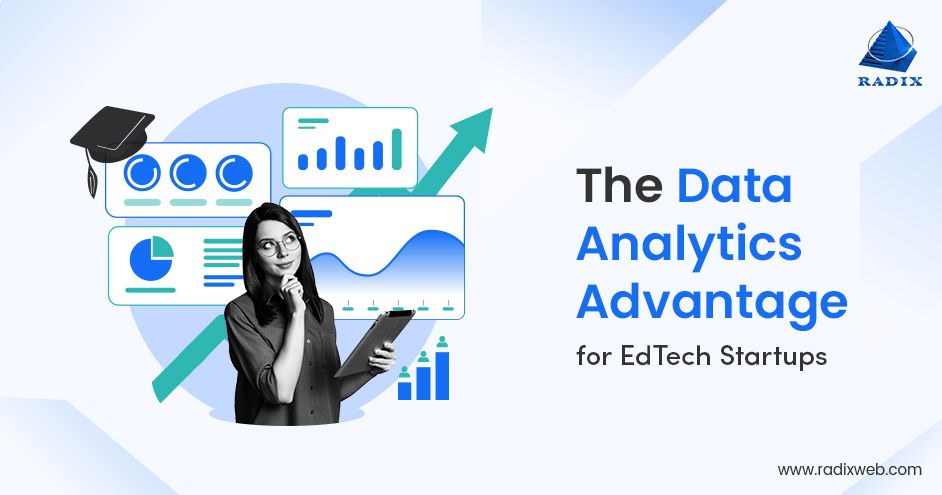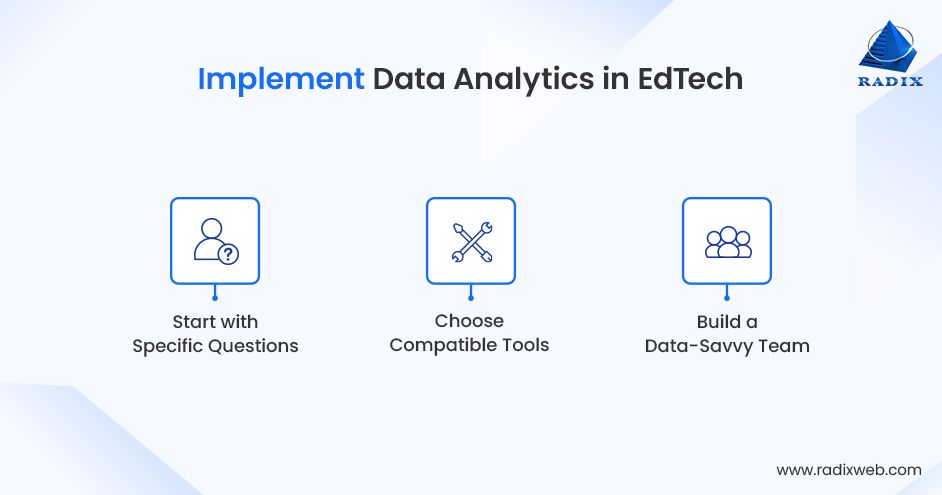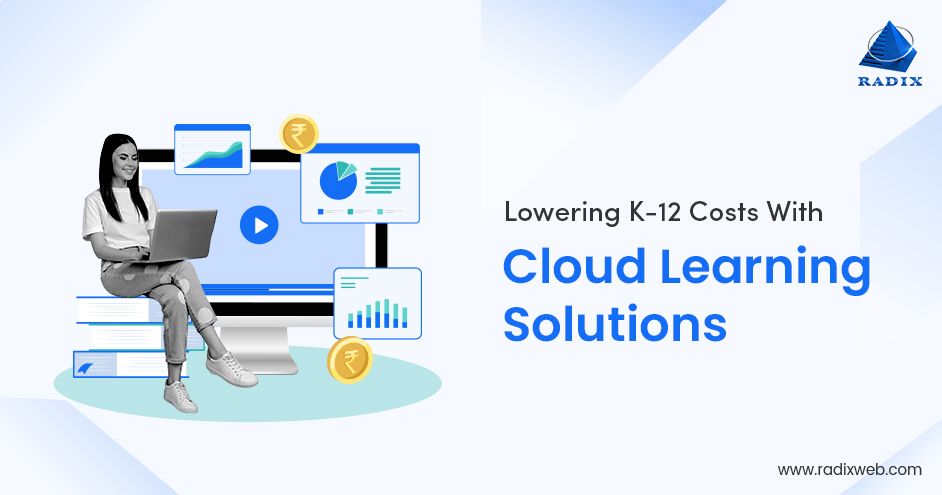Read More

Skip Setup Headaches and Start Your Project Fast - Download Free Boilerplates
How Data Analytics Is the Game Changer for EdTech Startups

Maitray Gadhavi

ON THIS PAGE
ON THIS PAGE
Quick Summary : Data analytics is a strong trend in EdTech. Why? Because 85% of educational institutions feel data analytics improves student outcomes. How? Data turns guesswork into precision, powers personalized learning, and ensures early interventions. With the right data, you can scale smarter, improve outcomes, and build trust. Not just with users, but investors too. Read on to know how.
At Radixweb, we’ve worked with several EdTech businesses. We've helped startups looking to scale. We've powered bigger enterprises looking to sustain their growth. And we've developed eLearning portals, training platforms, and many EdTech tools.
Irrespective of the scale, size, structure, niche, or geography, dashboards have been an important part of our EdTech project.
But for most businesses, data = dashboards.
But data is much more than that. Especially, for EdTech startups that can turn learner data into business leverage.
Let’s unpack how data analytics and education technology work hand-in-hand
What Is Data Analytics in EdTech?
At its core, data analytics in EdTech industry means turning raw educational data into actionable insights. That data can come from:
- Student activity (quizzes, logins, time spent)
- System metrics (content completion, bounce rates)
- Market signals (enrollment trends, user churn)
Once analyzed and interpreted, big data analytics for education guides everything from adaptive learning to product roadmaps
In fact, some eLearning statistics suggest that by 2027, the adaptive learning market will be worth $12.5 billion. This growth in personalized learning is also majorly fueled by the use of data analytics.
Because with the right analytics, you don't just know “what happened,” but “what’s likely to happen next” and what to do about it.
Learn more about what is data analytics here.
How Data Analytics Is Transforming Education?
Here are 5 powerful ways data analytics is transforming education.
1. Personalized Learning Paths
A rigid, one-size-fits-all approach once dominated traditional classrooms. Data analytics in EdTech makes it possible to break away from that. By continuously analyzing how each learner interacts with content platforms can dynamically shape the learning journey. The data that can now be analyzed and interpreted ranges from how long students linger on topics to where they struggle, and how they respond to assessments.
2. Predicting Student Drop-offs
Retention has always been a tough nut to crack in online learning. But data makes it far more manageable. Platforms now monitor subtle signals like:
- Declining logins
- Longer time gaps between sessions
- Skipped assignments.
These behavioral cues power predictive models that flag students who are likely to churn. Also, with big data analytics in education sector, platforms can process behavioral signals at scale
3. Measuring Content Effectiveness
Not all content performs equally, and analytics helps make that visible. Imagine thousands of learners consistently rewind the same section of a video. Or an entire batch underperforming on a specific quiz. These are signals that the concept may be poorly explained or too complex.
4. Improving Admin Efficiency
Most EdTech businesses focus only on student outcomes. But data analytics is quietly reshaping how educational teams operate behind the scenes. There are tools that analyze attendance patterns, assessment scores, and system usage. Insights from these tools help administrators forecast resource needs and identify at-risk classrooms. This saves time while improving support.
5. Refining Product-Market Fit
EdTech startups no longer need to rely on intuition to understand what’s working and where to grow. By slicing data by region, device type, or learning preference, they can make informed pivots. Such insights from big data analytics in education sector can help you shift both product and marketing toward higher-value segments.
Key Applications of Data Analytics in Education Industry
Data isn’t just for dashboards. It also trickles down to decision making. Here’s where (and how) data analytics in the education industry is driving real impact:
- Personalizing content delivery based on user behavior and learning patterns
- Tracking student engagement through clicks, scrolls, and time spent
- Enabling A/B testing to optimize features and content formats
- Benchmarking student performance against peer groups or averages
- Identifying at-risk learners early through progress and activity data
- Guiding product decisions by analyzing actual feature usage
- Helping educators tailor interventions based on individual student data
- Measuring the effectiveness of teaching methods across cohorts
- Improving retention by spotting and addressing drop-off patterns
- Supporting curriculum updates by analyzing topic-wise performance trends
These are just a few data analytics applications in education. Depending on your unique needs, there can be many other use cases of analytics in education sector worth exploring.
Empowering Educators: Data Analytics for Teachers
Too many people assume data is just for product teams. But data analytics for teachers is a quiet revolution in itself. Here’s how data-backed insights are helping educators:
Classroom-Level Insights
Teachers can identify struggling students early by analyzing question-level performance trends.
Content Feedback Loops
Engagement data helps teachers adjust lesson pacing and format based on how students respond.
Time Optimization
Automated reports and tracking reduce admin workload. This gives teachers more time to focus on teaching.
Personalized Instruction Plans
Student performance data enables teachers to tailor learning paths for different ability levels.
Real-Time Intervention Triggers
Behavioral patterns like skipped tasks or low engagement signal when a student may need timely support.
All-in-all, data empowers educators to teach smarter, respond faster, and support every student.
Also Read: How Software Development is Transforming EdTech
Implementing EdTech Data Analytics
Want to get started? Here’s how to implement EdTech data analytics techniques in a phased and manageable way:

Step 1: Define 2–3 focused questions you want data to answer, like “Why do students drop off mid-course?”
Step 2: Select analytics platforms that integrate with your LMS and offer flexible reporting as you scale.
Step 3: Train all teams to read dashboards and make everyday decisions backed by data.
Data Analytics Across EdTech Niches
No two areas of learning are the same. And the impact of data analytics in the education sector varies across domains. In K–12 settings, data analytics in the education industry often supports early interventions. It is made possible by identifying students who may be falling behind. In contrast, data analytics in higher education is used to track course engagement or predict graduation outcomes. Whether it’s personalized learning in schools or retention analytics in universities, each niche applies data differently based on its unique challenges and goals.
Speak to our education app development experts to see how you can leverage data analytics for your EdTech niche.
Data Analytics Challenges in eLearning [And How to Beat Them]
The eLearning industry is experiencing rapid growth and transformation. But that doesn’t mean there aren’t any challenges or roadblocks. These eLearning challenges also extend to data analytics in EdTech. However, these challenges aren’t impossible to solve. With proper planning, in-depth research, and experts who’ve done it before, these challenges can be mitigated with ease.
Let’s check out some of the top challenges in EdTech data analytics
Data Privacy & Security
Educational platforms must comply with laws like GDPR and FERPA by encrypting data, anonymizing users, and tracking access to protect trust.
Data Overload
Too many metrics can overwhelm teams - focus only on data that drives clear actions and decision-making.
Bias & Fairness
Biased training data can lead to unfair outcomes. So, it’s crucial to audit algorithms regularly, especially when decisions directly affect learners.
The solution?
Working with experts. By working with experts in data analytics in the education sector, you can ensure compliance, design meaningful metrics, and build fair, bias-aware systems. With experts, you get the right mix of tech, strategy, and ethical oversight to turn raw data into reliable, actionable insights.
Don’t Wait. Adopt Fast or Risk Falling BehindData analytics in EdTech industry is no longer experimental. It is essential. Those who adopt it early will build unfair advantages. Think smarter products, happier users, faster growth. And late adopters? They'll struggle with bloated platforms, disconnected features, and rising churn.So don’t wait for “enough data.” Start small. Measure what matters. And then scale data analytics with a proven roadmap.At Radixweb, we’ve done it before. And we are ready to do it again with your EdTech startup. If you are ready to start, schedule a strategy session with our team to discuss the way ahead.
Frequently Asked Questions
Do EdTech startups need data analytics?
What is data analytics in the context of EdTech?
Why is data analytics important for EdTech startups?
Can data analytics predict student performance?
How can data analytics enhance student engagement?
Can data analytics help improve course content?
Ready to brush up on something new? We've got more to read right this way.






